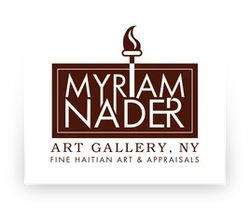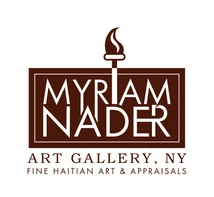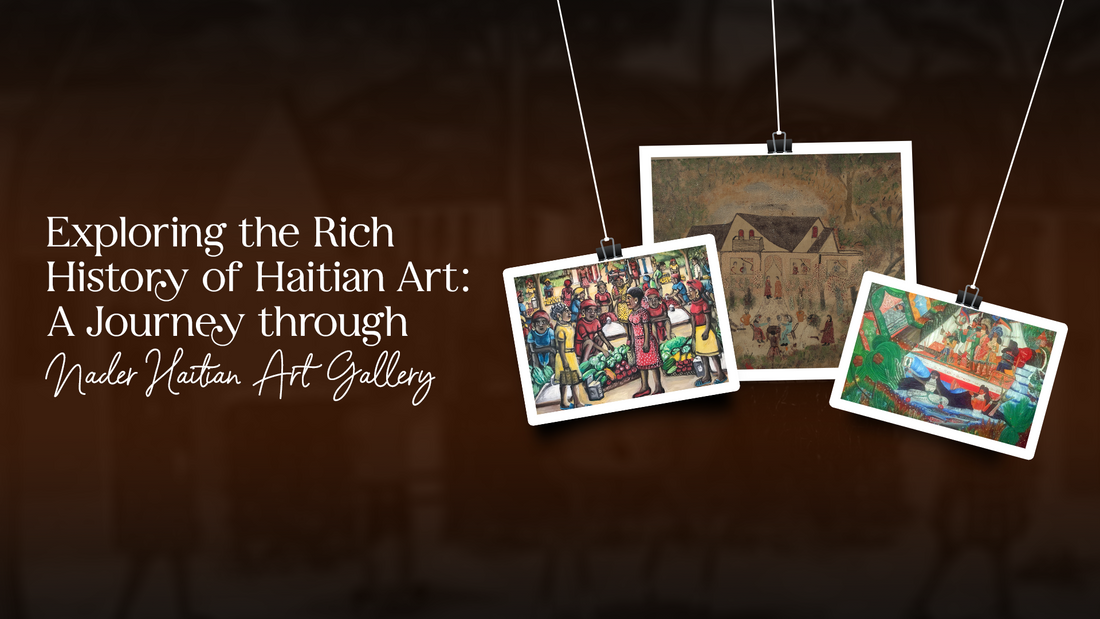Édouard Glissant, a renowned Martinican philosopher, once wrote, "Haitian painting challenges the magical notion of ‘authenticity’ in art. It is a community endeavor. An entire people’s discourse. The measure of its dynamism." These words resonate deeply as we explore the vibrant embrace of the Nader Haitian Art Gallery.
Haiti, a country full of history and resilience, has an artistic tradition as beautiful as its landscapes. It is a land filled with colors, rich culture, and a collection of stories built into its very essence. Join us as we explore on a journey through the rich history of Haitian art, where every stroke of the brush tells a tale and reflects the island's soul.
The Roots of Haitian Art
Our adventure began centuries ago, with the fusion of African, Indigenous Taíno, and European influences that shaped Haiti's unique cultural identity. As the first independent nation in Latin America and the Caribbean, Haiti's spirit of liberation and creativity is reflected through its creation.
In the gentle embrace of the sun's warmth, artists came together and found inspiration in the simplest of materials. They crafted paint from crushed stones and fashion brushes from humble sticks. Their canvases? Often, the very walls of their homes or scraps of fabric, transformed into vibrant expressions of creativity.
Most of these early Haitian artists weren't formally trained, but their passion burned brightly. They painted scenes of daily life like busy marketplaces, farmers tending their crops, and families celebrating together. They also depicted their rich cultural heritage, using symbols and figures from Vodou, a spiritual practice with roots in Africa.
However, there were sophisticated Haitian artists too who were professionals and learned to paint through formal education and training. They come from middle and upper-class backgrounds and have access to art schools, allowing them to refine their skills and techniques.
Unlike self-taught artists, they have studied under-established artists and follow contemporary art trends, contributing to the diverse landscape of Haitian art.

In Andre Pierre's painting "Ceremonie Erzulie Malade" (Ceremony of Sick Erzulie), we witness a scene from a voodoo ceremony. The canvas depicts the voodoo spirit Erzulie, known for her beauty and compassion, lying sick and surrounded by worshippers. A group of devotees is seen carrying Erzulie on a boat, as they transport her to receive care and healing.
Pierre's expressive style captures the spiritual intensity of the ceremony, inviting viewers to see the power of faith and community in times of need. This stunning masterpiece is a part of Myriam Nader's private collection, showcasing the talent of Andre Pierre. His work has been admired in exhibitions worldwide, leaving a lasting impression on art enthusiasts everywhere.
The Haitian Renaissance
The early 20th century marked a renaissance of Haitian paintings, powered by the work of visionary artists such as Hector Hyppolite and Philomé Obin. These artists embraced Haiti's folklore, mythology, and spirituality, infusing their creations with a sense of mysticism and vitality.

Hector Hyppolite's painting "Colonial House" showcases a vibrant house, built amidst lush greenery. Surrounding the house, we see hints of everyday life - servants working in the yard and adults chatting near the window side. The scene is bathed in sunlight, casting a golden glow over the colonial architecture and adding to the sense of joy.
Hyppolite's skillful use of oil paints brings this merry colonial house to life. This painting is published in " Mystical Imagination: The Art of Haitian Master, Hector Hyppolite" (Haitian Art Society).
The Movement of Naïve Art
One of the most unique aspects of Haitian artwork is its embrace of Naïve or "primitive" style. This movement, characterized by bold colors, simplified forms, and a childlike innocence, captured the imagination of artists both within Haiti and beyond.
Artists like Wilson Bigaud and Andre Pierre were big names in this style. They painted scenes of country life that felt alive and vibrant. We could see busy markets, beautiful countryside, and happy parties all in their paintings.

In Wilson Bigaud's (1931-2010) 12"x16" painting "To the Market," we witness a market scene filled with vibrant energy. People are busy moving in the market, carrying goods, and chatting with one another. Women with baskets balanced on their heads walk confidently, while vendors display their colorful array of fruits and vegetables.
Bigaud's skillful brushwork captures the essence of the market, inviting us to experience the lively hustle and bustle of Haitian daily life.
The Influence of the Saint Soleil Artists
In the 1970s, a bunch of artists formed a group called the Saint Soleil movement. They mixed traditional Haitian designs with a fresh kind of spiritual and abstract style. Jean-Claude Garoute and Maud Robart, talented painters, led this group. They wanted to go beyond just painting regular things and explore the world of the divine.
Their paintings feel like they are from another world, with swirling patterns, ghostly figures, and a vibe that makes you feel like you are floating. It's like they are speaking to your soul.
As word of their talent spread, famous Haitian paintings found their way beyond the villages and onto the international stage. Soon, collectors and art lovers worldwide were captivated by the raw energy and vibrant colors that defined this unique style.

In Levoy Exil's painting "Spirits and Snakes," we are transported into a mystical world where spirits intertwine with snakes. The spirits are depicted dancing and weaving among the serpents, their presence portrays a sense of ancient wisdom and power. Exil's painting invites us to observe the spiritual forces that shape our world and the interconnection of all living beings.
The Legacy of Nader Haitian Art Gallery
Georges S. Nader is the founder of Galerie d’ Art Nader in Haiti since 1966. The online art gallery known as, Myriam Nader Haitian Art Gallery was founded in 2007 by his daughter, Myriam Nader Salomon. She has been dealing with and appraising Haitian art since 1989 while also representing Haitian artists living abroad.
The Myriam Nader Haitian Art Gallery plays a pivotal role in preserving and promoting Haiti's artistic heritage. They have got a huge collection of art from way back, showing how creative Haitians have been over the years.
This gallery reminds us how art can bring people together, no matter where they're from, and help us understand each other better. It's like a big reminder of our shared human story.
Final Thoughts
Today, Haitian art continues to thrive. New generations of artists are keeping the traditions alive while adding their creative voices. They use everything from traditional techniques to modern materials, showcasing the ever-evolving story of Haiti.
So, next time you see a piece of Haitian art, take a moment to appreciate its rich history and vibrant spirit. It's a testimony to the creativity and resilience of the Haitian people.
Myriam Nader Haitian Art Gallery in New York offers the most impressive and important collection of Haitian artwork with a remarkable service experience specializing in selling and appraising Haitian art. Their mission is to make the world aware of Haiti's vibrant and unique fine arts. Don’t forget to explore their website.







 Log in
Log in
